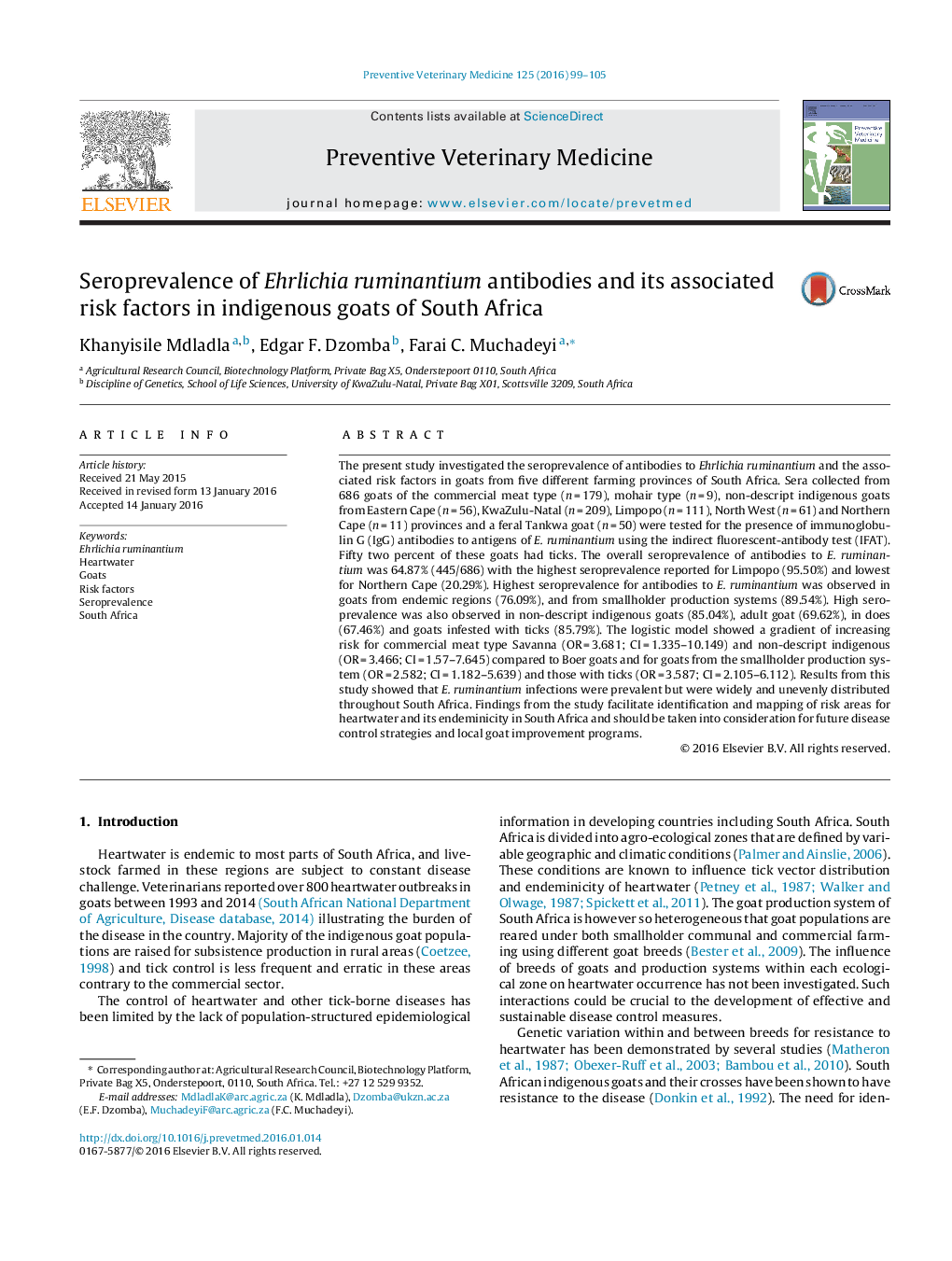| کد مقاله | کد نشریه | سال انتشار | مقاله انگلیسی | نسخه تمام متن |
|---|---|---|---|---|
| 5793000 | 1554163 | 2016 | 7 صفحه PDF | دانلود رایگان |
عنوان انگلیسی مقاله ISI
Seroprevalence of Ehrlichia ruminantium antibodies and its associated risk factors in indigenous goats of South Africa
دانلود مقاله + سفارش ترجمه
دانلود مقاله ISI انگلیسی
رایگان برای ایرانیان
کلمات کلیدی
موضوعات مرتبط
علوم زیستی و بیوفناوری
علوم کشاورزی و بیولوژیک
علوم دامی و جانورشناسی
پیش نمایش صفحه اول مقاله

چکیده انگلیسی
The present study investigated the seroprevalence of antibodies to Ehrlichia ruminantium and the associated risk factors in goats from five different farming provinces of South Africa. Sera collected from 686 goats of the commercial meat type (n = 179), mohair type (n = 9), non-descript indigenous goats from Eastern Cape (n = 56), KwaZulu-Natal (n = 209), Limpopo (n = 111), North West (n = 61) and Northern Cape (n = 11) provinces and a feral Tankwa goat (n = 50) were tested for the presence of immunoglobulin G (IgG) antibodies to antigens of E. ruminantium using the indirect fluorescent-antibody test (IFAT). Fifty two percent of these goats had ticks. The overall seroprevalence of antibodies to E. ruminantium was 64.87% (445/686) with the highest seroprevalence reported for Limpopo (95.50%) and lowest for Northern Cape (20.29%). Highest seroprevalence for antibodies to E. ruminantium was observed in goats from endemic regions (76.09%), and from smallholder production systems (89.54%). High seroprevalence was also observed in non-descript indigenous goats (85.04%), adult goat (69.62%), in does (67.46%) and goats infested with ticks (85.79%). The logistic model showed a gradient of increasing risk for commercial meat type Savanna (OR = 3.681; CI = 1.335-10.149) and non-descript indigenous (OR = 3.466; CI = 1.57-7.645) compared to Boer goats and for goats from the smallholder production system (OR = 2.582; CI = 1.182-5.639) and those with ticks (OR = 3.587; CI = 2.105-6.112). Results from this study showed that E. ruminantium infections were prevalent but were widely and unevenly distributed throughout South Africa. Findings from the study facilitate identification and mapping of risk areas for heartwater and its endeminicity in South Africa and should be taken into consideration for future disease control strategies and local goat improvement programs.
ناشر
Database: Elsevier - ScienceDirect (ساینس دایرکت)
Journal: Preventive Veterinary Medicine - Volume 125, 1 March 2016, Pages 99-105
Journal: Preventive Veterinary Medicine - Volume 125, 1 March 2016, Pages 99-105
نویسندگان
Khanyisile Mdladla, Edgar F. Dzomba, Farai C. Muchadeyi,